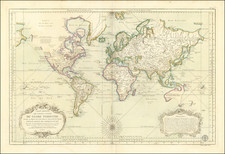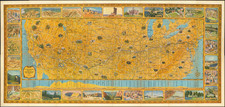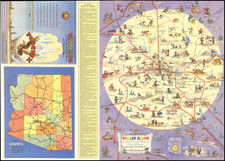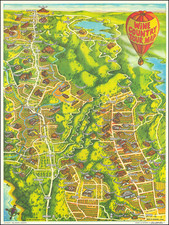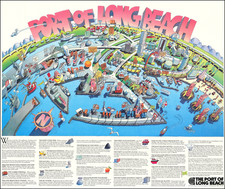The Original Artwork For One of The Most Iconic Pictorial / Political Satire Maps
Liberty in Totalitarian Eclipse
Well preserved example of the original artwork for this provocative satirical pictorial map, addressing the varying levels of control of free speech exercised around the world, drawn by William Henry Cotton.
The illustration by Cotton, which served as the central double-page spread in the inaugural issue of Ken magazine, issued in April 1938, stands as a notable artifact of pre-World War II American culture. Ken magazine, recognized for its anti-Fascist stance, chose this piece for its powerful political commentary. The artwork, replicated without notable alterations in the design from the maquette to the final print, is nearly double the size of the its magazine counterpart. It employs satire to cast a critical eye on the global political landscape of the era, with a focus on the exaggerated presence of dictators.
The exaggerated depictions serve as a form of political satire, intended to critique and draw attention to the authoritarian regimes that were gaining power at the time. This artistic choice underscores the urgency and the heightened political concerns of the era, reflecting the widespread apprehension about the future course of international relations and the potential for global conflict.
In retrospect, this illustration gains additional significance when viewed through the lens of historical events that unfolded shortly thereafter. The years following the publication of this map saw the escalation of global tensions leading to the outbreak of World War II, validating the concerns expressed through this satirical artwork. The map thus serves as a prescient commentary on the political dynamics of its time, offering valuable insights into the era's cultural and political discourse.
The map illustrates the nature of governments based upon 3 types:
- Dictatorial Control of the Agencies of Public Communication
- Varying Degrees of Control, Censorship and Intimidation
- Relative Freedom from Official Supervision
The commentary below the map is instructive on its world view, identifying "ten adult bipeds, each equipped with distended ego and outsized adrenal glands, whose ten totaled brains wouldn't counterbalance that of one Einstein in the measurement of man's distance from the anthropoid ape."
Of note, Cotton has adapted and satirized Deal Carl Ackerman's contemporary "map of the black plague in the 20th Century" for this work. As noted by the PJ Mode Collection of Persuasive Cartography at Cornell University website description for this map:
A powerful satirical commentary on totalitarian control of speech from the first issue of Ken Magazine. "Caught here in all their peculiar beauty by the soul searching stylus of W. Cotton, Ken holds up for wonder the mangy motley pack of little 'strong men' who are now leading the world on a backward march to the Dark Ages. . . . In effect, over more than half the world, Liberty is now in totalitarian Eclipse." Each country is characterized by the degree of "dictatorial control" over communication. Each of the totalitarian leaders is named and shamed ("His Blood-red Loneliness, Nobody's Comrade, Stalin").
Ken was a controversial anti-fascist magazine, first published in April 1938. It was distinguished by unusual and powerful graphics like this one and a number of articles on the Spanish Civil War by Ernest Hemingway. The magazine failed in August 1939 as a result of wariness by advertisers and a boycott by the Catholic Church (Baptista 2009, 109-115).
William Henry Cotton
William Henry Cotton (1880 - 1958) was an American portrait painter, caricaturist, and playwright. Cotton studied painting with Joseph DeCamp and Andreas Anderson at the Cowles Art School in Boston, and then at the Académie Julian in Paris with Jean-Paul Laurens.
He was a founder of the National Association of Portrait Painters and a member of the Newport Art Association. Cotton exhibited at the National Academy of Design in New York City, the Corcoran Gallery of Art in Washington, DC, the Art Institute of Chicago, the Pennsylvania Academy of the Fine Arts, and the Saint Louis Art Museum. He was also invited by the government of France to exhibit at the Musée du Luxembourg. In 1916, he was elected into the National Academy of Design as an Associate Academician.
After a successful career as a portrait painter, he began working as a caricaturist for Vanity Fair in 1931 and for The New Yorker the following year. In 1931, the New York Repertory Company produced a comedy he wrote, "The Bride the Sun Shines On", at the Fulton Theatre in New York.
He also painted mural decorations for New York City theaters, including the Capitol, Apollo, Times Square, and Selwyn theaters.











![[Early Fascimile of the Disputed Christopher Columbus Portolan Chart]](https://storage.googleapis.com/raremaps/img/small/66588.jpg)
